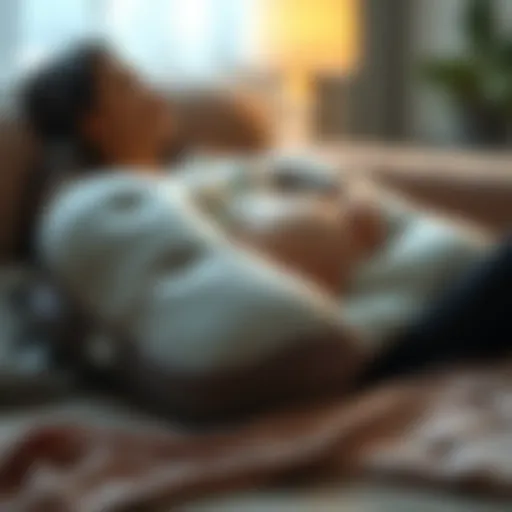Discovering the Beauty of Moroccan Style Table Runners
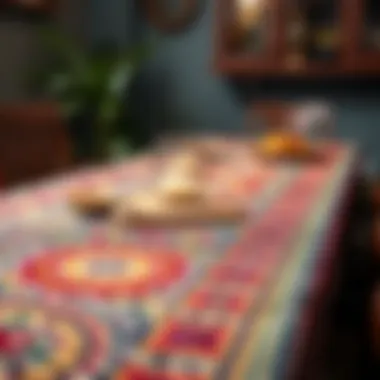
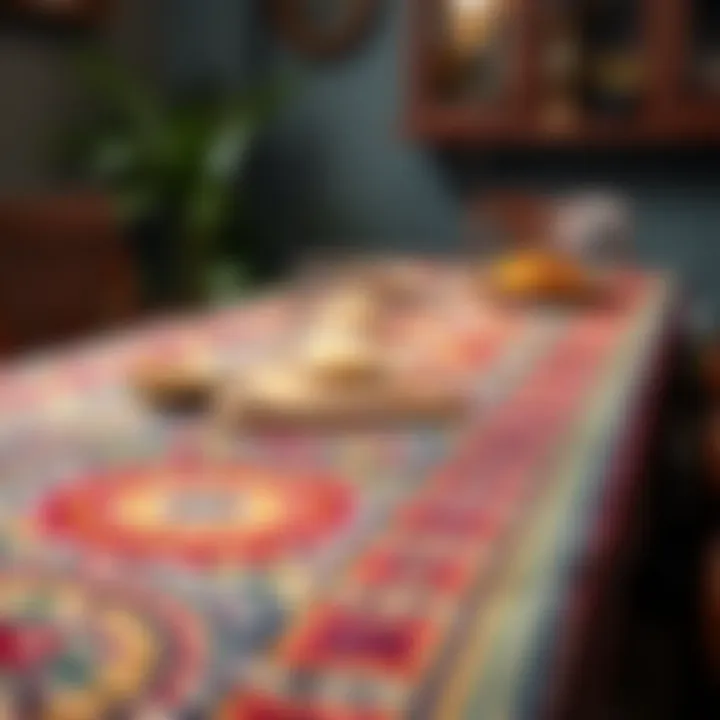
Intro
Moroccan style table runners embody a unique blend of artistry, history, and cultural significance. These textiles are more than mere decorative items; they tell stories woven through generations, reflecting the essence of Moroccan heritage. As we journey through the intricate designs and careful craftsmanship of these table runners, we will uncover their various fabric types, traditional patterns, and the cultural narratives that influence their creation.
In an age where home decor becomes an expression of personal identity, incorporating Moroccan table runners can add an exotic touch while providing a deeper connection to a rich culture. This piece explores the dimensions involved in selecting the perfect runner for your space, understanding the materials, and the importance of care and maintenance. Join us as we explore not just the aesthetic appeal, but also the significance behind each thread.
Fabric Knowledge
Types of Fabrics
The fabrics used in Moroccan table runners are integral to their character. Commonly seen materials include cotton, wool, and silk, each bringing its distinctive look and feel.
- Cotton: This fabric is breathable and often used for everyday table runners. Cotton runners can withstand frequent washing and are available in vibrant colors, making them ideal for casual settings.
- Wool: Known for its durability and warmth, wool is often used in more traditional designs. Wool runners may feature intricate patterns and textures, suitable for creating a cozy atmosphere during colder seasons.
- Silk: Luxurious and elegant, silk is not as commonly used for everyday items. When found in table runners, silk elevates the aesthetics to a more refined level. These pieces often serve as statement decor rather than functional items.
The choice of fabric is paramount depending on the function and ambiance one wishes to create.
How to Care for Different Fabrics
With the diversity of fabrics comes different maintenance needs. Understanding how to care for your Moroccan table runner ensures its longevity and preserves its beauty.
For cotton runners, machine wash in cold water and avoid the use of bleach, which may fade colors. Line drying is recommended to prevent shrinkage.
Wool requires a bit more delicate handling. Spot cleaning is often best, though hand washing can be done gently. Dry flat and avoid hanging, as this can distort its shape.
If you have a silk runner, it’s best to dry clean. However, should you need to wash it at home, use cold water and a gentle detergent. Always air dry, keeping it out of direct sunlight to avoid fading.
Style Tips
Incorporating Moroccan table runners into your decor can be approached with creativity and style.
Pairing Strategies
Consider the surrounding elements of your dining space. A vibrant geometric pattern may work well against solid wooden tables.
- Contrast is Key: A brightly colored runner against a neutral table creates a striking look.
- Layering: Combine a runner with placemats or napkins that complement its pattern. This adds depth and texture to your table setting.
Seasonal Trends
During festive seasons, lean towards runners with intricate designs or rich colors which reflect the spirit of holidays. In contrast, lighter, pastel fabrics work well for spring gatherings, bringing a fresh look to your dining area.
Understanding Moroccan Style
Delving into Moroccan style reveals a tapestry rich with history, artistry, and cultural meaning. Understanding this style is essential, particularly when we look at table runners, as they are not mere decorative items. They represent a fusion of tradition and contemporary aesthetics, offering storytelling elements woven within their fibers. With a background steeped in cultural significance, each runner encapsulates the essence of Moroccan heritage, making it a vital consideration for anyone wishing to elevate their home decor.
Cultural Background
The cultural underpinnings of Moroccan table runners are broad and deeply rooted. Originating from a blend of Berber, Arab, and French influences, the designs reflect a diversity that is both fascinating and beautiful. Table runners often incorporate symbols and motifs that carry specific meanings, echoing the artists' intent and the stories of their ancestors.
For example, geometric patterns commonly seen are not just for aesthetic allure; they signify harmony and balance. Colors used in these textiles often have layered meanings, with vibrant reds and deep blues conveying warmth and protection. These runners are indeed cultural artifacts, embodying the stories of artisans who have maintained their crafts over generations. This cultural backdrop is essential for anyone looking to understand not just the appearance of Moroccan table runners, but their essence.
Historical Influences
History paints a vivid picture of how Moroccan table runners have evolved. The historical influences on these textiles can be traced back to the ancient trade routes that once spanned North Africa. The Silk Road, for instance, facilitated the exchange of materials and techniques, allowing Moroccan artisans to incorporate diverse influences into their designs. The introduction of techniques from various civilizations enriched the local craftsmanship in ways that still resonate today.
Additionally, political events over centuries—including the rise and fall of dynasties—shaped the stylistic choices of artisans. The intricate designs seen today are often a reflection of the eclectic mix of cultures that have passed through Moroccan lands, making every runner not just a decor piece, but a slice of history.
Artistic Expression
Artistic expression in Moroccan table runners is both practical and profound. Weaving and dyeing techniques are passed down through generations, embodying a sense of pride and identity among artisans. Creativity flows in the myriad of textures and patterns created, whether through intricate embroidery or the choice of materials. Skilled artisans apply ancient techniques, such as loom weaving, to bring designs to life, ensuring that each piece is unique.
Moreover, the artistic process is often a communal activity, with workshops in cities like Marrakech buzzing with collaboration. This sense of community fosters innovation while also preserving traditional practices.
Beyond mere aesthetics, each table runner tells a personal story, reflecting the culture and experiences of its maker. Understanding this artistic expression allows one to appreciate the time-honored craftsmanship that goes into Moroccan textiles and their significance within interior decor.
"Each piece of craftsmanship speaks of the land, the people, and the stories that define it. In Moroccan culture, textiles are woven with the threads of life itself, making them truly special."
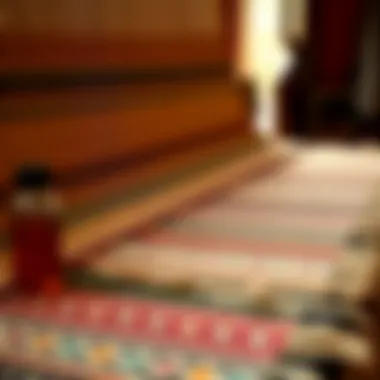
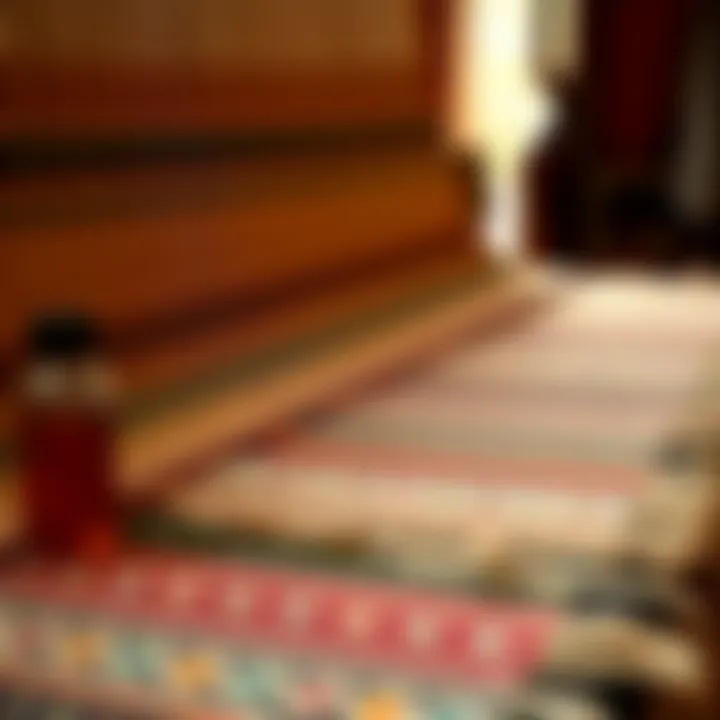
In wrapping this section, it becomes clear that Moroccan style is an avenue to explore a rich wholesomeness—a blend of culture, history, and artistry. As we move forward in this article, these elements will be crucial in contextualizing Moroccan table runners within both historical practice and modern decor.
Characteristics of Moroccan Table Runners
The uniqueness of Moroccan table runners cannot be overstated. These pieces are not merely decorative; they embody a rich history and cultural significance that resonates deeply with those who encounter them. Understanding the characteristics of these textiles helps one appreciate how they can elevate a space, serving both aesthetic and functional purposes. From their roots in traditional craftsmanship to the vibrant colors and patterns, Moroccan table runners invite one into a world where art and culture intertwine beautifully.
Traditional Fabrics
One of the defining features of Moroccan table runners is the fabric used to create them. Premium materials such as wool, cotton, and silk are common, each bringing its intrinsic qualities to the table. Wool, for instance, offers warmth and durability, making it an excellent choice for both everyday use and more formal occasions. Cotton adds a soft touch that often feels refreshing against the skin, suitable for summer gatherings.
In Moroccan culture, fabric sourcing is steeped in tradition. Local artisans select materials that reflect the environment around them, featuring natural dyes derived from plants and minerals. This results in an organic, earthy palette that resonates with the landscapes of Morocco. The choice of fabric not only affects the look but also the feel and longevity of the runner, making it vital in the selection process.
Distinct Patterns and Colors
Moroccan table runners are famed for their intricate patterns and lively colors. Geometric shapes interlace with organic designs, telling a story that reflects the landscape, flora, and fauna of Morocco. It’s a visual feast that combines various influences, from Berber motifs to Andalusian details.
Each color in a Moroccan runner has a significance—deep reds can symbolize love and passion, while blues often evoke tranquility, mirroring the sea and sky. When selecting a runner, it's essential to consider how these colors align with the mood or atmosphere you want to create in your space. The patterns often celebrate the imperfection of handcrafted textiles, reminding us that beauty often lies in the unique and the authentic.
Textures and Weaving Techniques
Texture plays a critical role in the appeal of Moroccan table runners. The techniques used in weaving vary significantly from region to region, resulting in a rich tapestry of textures. Handwoven pieces often showcase a somewhat uneven texture that speaks to the human touch behind their creation. This tactile quality can bring depth to your decor, making it more inviting.
Techniques such as kilim weaving or boujad often result in a flatweave that is soft yet durable. Other methods, like those used for shaggy designs, provide an interesting contrast. When touched, these runners can evoke a sense of warmth and coziness, inviting you to linger a little longer at the table. Incorporating textured pieces can create a balance in your decor, marrying sleek surfaces with warmth and character.
"Each piece tells a story, blending the past and present into an artifact of beauty."
In summary, the characteristics of Moroccan table runners are deeply interwoven with the cultural fabric of Morocco itself. Fabrics, patterns, colors, and textures work in delightful harmony, offering a multifaceted understanding of how these pieces can enliven any home. Recognizing these elements can significantly influence how one styles their space, making each dining experience not just functional but also a celebration of artistry.
Inciting Elegance in Home Decor
The incorporation of Moroccan style table runners in home decor is more than just a decorative choice; it's about weaving narratives from a rich cultural tapestry into modern living spaces. These textiles act as focal points that not only enhance the aesthetic appeal of a room but also evoke a sense of shared history and tradition. In this section, we explore the various elements and benefits that highlight the importance of Moroccan table runners in enticing elegance into home decor.
Integrating with Various Styles
When it comes to decor, one of the key aspects is the ability to harmonize different styles into a cohesive look. Moroccan table runners possess an inherent versatility that makes them compatible with a myriad of design aesthetics. Whether the setting is modern, rustic, or eclectic, these pieces can bridge styles and introduce a splash of cultural vibrancy.
- Modern Minimalism: In a space defined by clean lines and minimalist furniture, a bold Moroccan table runner creates a striking contrast. Think sleek white surfaces or black furniture paired with a vibrant runner showcasing traditional geometrics or rich colors. This juxtaposition speaks volumes, marrying simplicity with intricacy.
- Rustic Charm: For homes boasting rustic elements—like reclaimed wood and vintage furnishings—a Moroccan table runner seamlessly enhances the warmth of the space. Choosing patterns with earthy tones can evoke the natural, organic feel that resonates well with rustic decor.
- Eclectic Mix: In an eclectic setting brimming with colors and textures, Moroccan table runners serve as a unifying element. Their intricate designs and lush patterns can tie together a variety of thrown-together decor, creating an aesthetically pleasing chaos that feels intentional rather than haphazard.
Creating Atmosphere with Table Runners
The ambiance of a room often hinges on its decor, and Moroccan table runners play a pivotal role in shaping that mood. The right runner can transform an ordinary dining experience into an extraordinary event. Consider how the sensory elements of these textiles impact the space:
- Cultural Representation: By displaying a Moroccan runner during gatherings, hosts can share a piece of Moroccan culture with their guests. It invites conversations about its origins and craftsmanship, turning a dinner into an educational experience.
- Visual Warmth: The vibrant colors and unique patterns of Moroccan runners can evoke feelings of warmth and hospitality. A bright orange or deep blue can immediately draw the eye, making any table feel more inviting and festive.
- Layering Textures: When combined with centerpieces, plates, and glassware, a Moroccan runner not only serves as a backdrop but adds depth to the table setting. Layering different textures can create a tactile richness that enhances the dining experience.
Pairing with Other Decor Elements
To fully leverage the elegance brought by Moroccan table runners, thoughtful pairing with other decor elements is essential. The interplay between various components of the decor can elevate a space into a visually stimulating environment.
- Tableware Coordination: Choosing tableware that complements the colors within the table runner can create a harmonious look. For instance, simple white dishes can offset a busy runner, allowing it to be the star of the show while maintaining balance.
- Complementary Textiles: Pairing Moroccan table runners with matching or contrasting placemats or napkins can enhance the overall decor. Think about rich textured napkin rings or subtle runners in muted colors to keep things sophisticated without overwhelming the visual narrative.
- Natural Elements: Incorporating flowers, candles, or fruit bowls can bring an organic touch against the rich textile backdrop. These elements serve to both soften the look and enhance sensory appeal, allowing for a well-rounded decor scheme.
Choosing the Right Moroccan Table Runner
Selecting a Moroccan table runner is not merely about aesthetic preference; it can significantly affect the overall ambiance of your space. In this section, we will explore vital considerations that contribute to finding the ideal piece. The right table runner blends functionality with visual appeal, serving not just as decor but also as a way to express cultural appreciation.
Size Considerations
When choosing a table runner, size is king. A runner that’s too short may look out of place, while one that’s excessively long could overwhelm a dining area. The general rule of thumb suggests that the runner should extend at least six inches on each side of the table. For example, a six-foot table typically pairs well with a runner between 72 to 84 inches long.
- Table Width: Ensure that the runner’s width complements the table's dimensions. A narrow width might elongate the table's look, while a broader runner can provide a cozier feel.
- Height Clearance: Always consider the height of dining chairs or surrounding furniture. A table runner should not interfere with diners' comfort.
Ultimately, measuring before making a purchase can save time and money, ensuring the runner suits your table perfectly.
Style Compatibility
Beyond size, style must align with your existing décor. Moroccan table runners come in various styles, from intricate tribal patterns to modern interpretations. Understanding your interior style helps narrow down choices to those that complete your space.
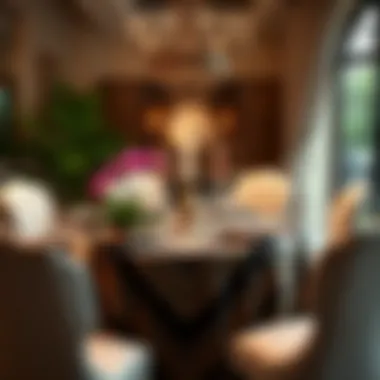
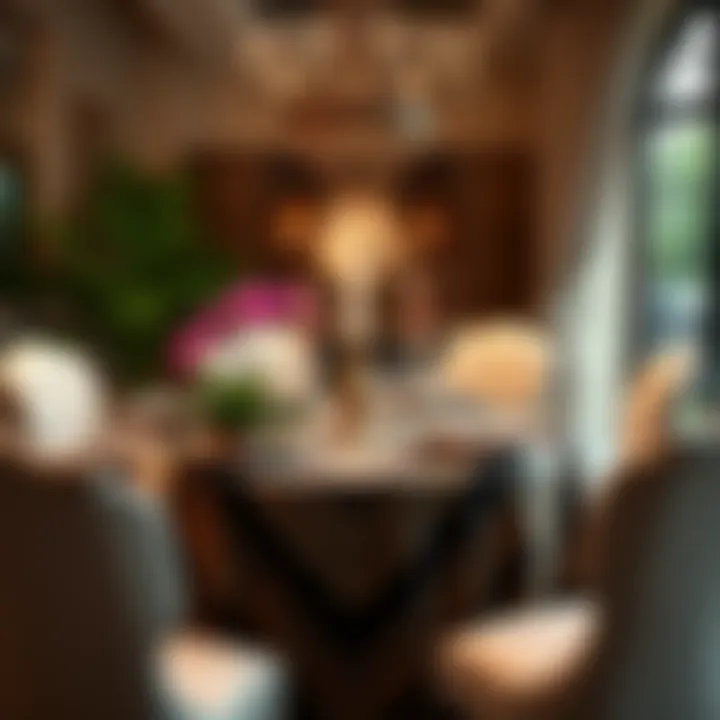
- Boho Chic: If your home reflects a carefree bohemian vibe, choose a colorful runner with geometric patterns or tassels.
- Mid-Century Modern: For a more minimalistic aesthetic, opt for subtly patterned runners that enhance simplicity.
- Rustic Farmhouse: Earthy tones and textures resonate well; a woolen runner with muted patterns may be just the ticket.
Aligning style ensures that your choice feels intentional and cohesive instead of whimsical or out of place.
Functionality and Purpose
Lastly, consider the function of the runner. Moroccan table runners can serve multiple purposes, enhancing both utility and elegance. Think about how the runner will be used:
- Everyday Dining: If it’s for daily use, durability and easy maintenance should be priorities. Look for materials that stand up to spills and regular washing.
- Special Occasions: For gatherings or festive meals, you might choose a more ornate design that stands out and elevates the dining experience.
- Decorative Touch: If the table runner is meant to accentuate other décor elements, ensure that it complements your centerpiece and any existing accessories, such as candles or dishes.
Consideration of size, style, and functionality is key to making a choice that resonates.
In summary, taking these considerations into account ensures you choose a Moroccan table runner that not only enhances the beauty of your space but also serves its intended purpose. By diving deeper into the specifics above, it’s possible to make a thoughtful investment that stands the test of time.
Care and Maintenance
Caring for Moroccan style table runners requires a combination of attentiveness and understanding of the materials involved. Unlike mass-produced fabrics, these unique runners reflect the artistry of their weavers and artisans, making proper care essential for maintaining their beauty and integrity. Prioritizing care not only ensures longevity but also respects the cultural significance embedded in these textiles.
Washing and Cleaning Instructions
To ensure the vibrancy and quality of your Moroccan table runner, follow these washing and cleaning guidelines:
- Gentle Hand Washing: It’s often recommended to wash these textiles by hand using mild detergent. Fill a basin with lukewarm water, add a few drops of detergent, and gently swish the runner through the water. Avoid vigorous scrubbing, as it could fade or damage the fabric.
- Spot Cleaning: For minor stains, a damp cloth with a drop of soap can work wonders. Gently dab the stained area—precautions should be taken to refrain from rubbing the fabric too harshly.
- Machine Washing: If hand washing isn't feasible, select a gentle cycle on your machine and place the runner in a mesh laundry bag. It’s best to wash it in cold water and avoid bleach altogether. Always read the care label for specific washing instructions.
- Drying: Air drying is preferable. Lay the runner flat on a clean surface or hang it to dry away from direct sunlight to prevent color fading.
Storing Your Table Runners
Proper storage is critical in prolonging the life of your Moroccan table runner. Consider the following tips:
- Avoiding Folding: To prevent crease marks and pressure points that can damage the fibers, store the runners rolled rather than folded. This will help them maintain their shape and texture.
- Cool, Dry Spaces: Keep runners in a cool, dry place away from direct sunlight, which can cause fading. A storage box or a cupboard lined with acid-free tissue paper can provide an ideal environment.
- Regular Check-Up: Every few months, take your runners out to inspect for any signs of mold or pests. This proactive approach can keep your textiles safe and ready for use whenever needed.
Handling Wear and Tear
Though designed for beauty, Moroccan table runners are not immune to wear and tear, especially with frequent use. To manage and minimize any damage:
- Repair Instead of Replace: Minor frays or loose threads can often be repaired at home. Use a needle and thread in a matching color to mend small tears. For more severe damage, consider consulting a professional who understands the nuances of these fabrics.
- Rotate Regularly: If using the runner frequently, rotating its position on the table can help distribute wear evenly. This approach not only extends its life but also showcases different aspects of its design.
- Avoiding Contact with Sharp Objects: Be cautious about placing anything sharp or excessively heavy on the table runner. Keeping it free from items that may snag or cut the fabric will help preserve it.
Remember, caring for your Moroccan table runner is about creating a respectful relationship with a piece of culture. Every stain, every thread holds a story.
By adhering to these care and maintenance tips, you can ensure that your Moroccan table runners remain beautiful and functional, becoming cherished pieces in your home for years to come.
Buying Guide for Moroccan Table Runners
When considering the purchase of Moroccan table runners, understanding various factors plays a crucial role in making an informed decision. Unlike standard table coverings, Moroccan table runners ooze rich cultural significance and artistic expression. Thus, knowing what to look for elevates the entire buying experience not just to a simple transaction, but to an opportunity to connect with a vibrant tradition and craftsmanship.
Top Retailers and Craft Markets
Finding the right place to buy Moroccan table runners can feel like searching for a needle in a haystack. However, there are several reliable spots that specialize in these unique textiles. Local artisan markets in Morocco can be a treasure trove; cities like Marrakech have bustling souks where artisans showcase their work. These markets are more than just shopping venues; they are vibrant cultural hubs where one can observe traditional weaving techniques firsthand.
For those of us not able to travel to Morocco, online platforms such as Etsy and Fair Trade Supply offer extensive selections of handmade Moroccan table runners. These platforms often provide direct support to the artisans, ensuring that the craftsmanship is preserved and appreciated.
Understanding Price Ranges
When it comes to pricing, the variation for Moroccan table runners can be extensive. Factors influencing the price include the quality of fabric, intricacy of the patterns, and the complexity of the weaving techniques. On average:
- Lower-end range: $30 to $50 for simpler designs, often made from cotton blends.
- Mid-range: $60 to $120 for more elaborate handcrafted pieces that feature unique patterns.
- High-end: $150 and above for luxury items made from premium materials such as silk or high-quality wool, often boasting detailed artistry and exceptional craftsmanship.
Remember, while it’s tempting to opt for cheaper options, investing in higher quality can enhance durability and aesthetic appeal, making them worthwhile in the long run.
Evaluating Quality and Authenticity
Ensuring that the Moroccan table runner is of high quality and authentic to its origins is essential. Here are some tips to help you evaluate authenticity when purchasing:
- Look for Handwoven Details: Handcrafted table runners often bear slight imperfections, which add to their character. Perfectly machine-made items may lack the unique traits of artisanal work.
- Check Material Composition: Authentic pieces are typically woven from natural fibers like wool, cotton, or silk. If the product lists synthetic materials, be cautious.
- Research Artisan Tags or Labels: Some artisans attach labels detailing their story or origin, which can provide assurance of authenticity.
- Seek Out Customer Reviews: Feedback from previous buyers can shed light on the quality and craftsmanship of the runner.
- Ask Questions: If shopping online, don’t hesitate to reach out to sellers for additional information about their products and sourcing practices.
In wrapping it up, buying a Moroccan table runner is more than just a decorative purchase; it’s an investment in culture and artistry. Each thread is woven with stories and tradition that transcend borders. As with anything valuable, a bit of research mixed with a discerning eye goes a long way.
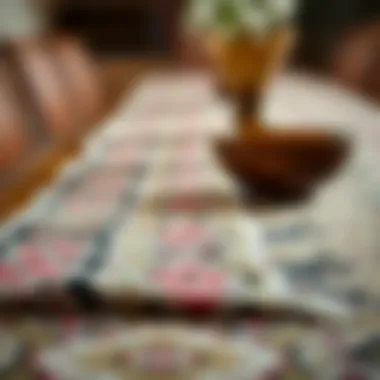
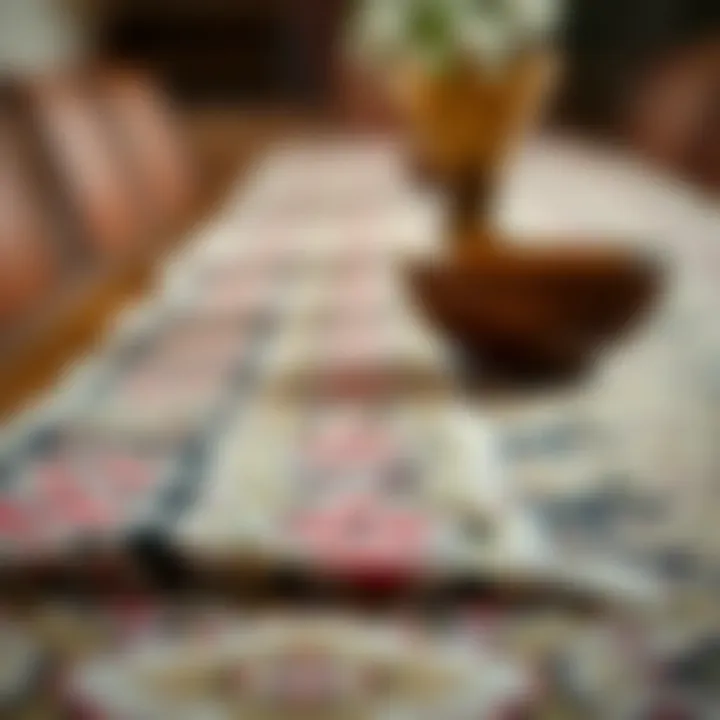
Incorporating Moroccan Style into Everyday Life
Integrating Moroccan style into daily living spaces goes beyond mere aesthetics; it encompasses a rich tapestry of culture, tradition, and personal expression. Table runners, in particular, serve as versatile textiles that can greatly enhance the ambiance of any setting. The characters of Moroccan artistry—vivid colors, intricate patterns, and remarkable craftsmanship—contribute not only beauty but also a sense of connection to Morocco's storied past. This section explores methods to incorporate Moroccan style seamlessly into everyday life, making it relevant for those looking to infuse their home decor with warmth and character.
Hosting Gatherings with Style
When it comes to hosting gatherings, the right table runner can truly set the stage. Picture a warm afternoon with friends gathered around a beautifully set table; a Moroccan runner drapes gracefully across the surface, drawing the eye with its detailed weaving. This textile doesn't just act as a buffer against scratches or spills; it becomes a talking piece, sparking conversations about its origins and intricacies. Consider choosing a runner that complements your tableware—soft earthy tones can bring a rustic charm, while bold hues can inject energy and vibrancy into the room. Moreover, by incorporating locally crafted table runners, you support artisans and celebrate the craftsmanship that goes into every piece.
Using Table Runners in Different Settings
Versatility defines Moroccan table runners. They can easily transition between casual breakfasts and formal dinners. In casual settings, they could be layered over simple linen tablecloths to add texture without being overwhelming. For more formal occasions, a richly designed runner can stand alone atop a polished table, highlighting the grandeur of the meal served. Place settings can also reflect Moroccan influence by adding complementary decor, such as patterned plates or decorative lanterns, enhancing the overall aesthetic and creating a cohesive look.
Seasonal Decor Ideas
Adapting Moroccan table runners for different seasons is a fantastic way to keep your decor fresh and engaging. In fall, consider rich burgundies and deep oranges that echo the changing leaves. Spring can bring in lighter fabrics adorned with floral patterns that mimic the blooming landscape. Allowing table runners to transition with the seasons creates a dynamic atmosphere in your home. To fully embrace each season, consider pairing your runners with themed centerpieces—pumpkins for autumn or floral arrangements for spring. This not just shows creativity but also ensures that your decor tells a story throughout the year.
Incorporating Moroccan elements into daily life sustains a cultural dialogue, enriching both your home and your understanding of global artistry.
By weaving Moroccan style into everyday activities—be it hosting a dinner party or merely enjoying a quiet meal—you elevate your surroundings and foster an appreciation for this incredible heritage. Each table runner you choose tells a piece of Morocco's story, integrating its vibrant culture into your personal narrative.
Cultural Appreciation and Responsiveness
Understanding the depth of Moroccan style table runners goes beyond their aesthetic allure. It's about nurturing a respect for their roots, their makers, and the cultural narratives they embody. Cultural appreciation ensures that individuals not only recognize the beauty of these textiles but also grasp the significance of their craftsmanship. This appreciation leads to broader insights about what such items represent within Moroccan society.
Respecting Craftsmanship
Craftsmanship in Moroccan textiles is rich and intricate. The artisans employ techniques passed down through generations, blending traditional methodologies with personal expressions. Each piece of fabric is not merely a product but a testament to the labor and skill of the craftsman.
When choosing a Moroccan table runner, one ought to consider not just its appearance but also the story it tells. Engaging with the artisans and understanding their processes enriches the experience of owning such textiles. Supporting local methods promotes a greater respect for the work involved, allowing the artisans’ legacies to thrive. This respect for craftsmanship ultimately results in a deeper, more meaningful connection between the buyer and the product.
"It's not just about buying a product; it's about cherishing the journey and the hands that made it."
Understanding Cultural Context
To fully appreciate Moroccan table runners, one must grasp their cultural relevance. These textiles often carry symbols and motifs that reflect Morocco's diverse history, from Berber influences to Arab and African connections. Patterns may signify various aspects of life, beliefs, or even societal commentary, making each runner a dialogue with the viewer.
Recognizing these cultural contexts fosters a sensitivity in the modern decor landscape. It supports a bridging of cultures rather than a superficial adoption. This understanding is essential for anyone in fashion or retail, as it demands a conscientious approach to sourcing and selling these products. Engaging in this dialogue can lead to a greater appreciation and respect among consumers and creators alike.
Supporting Artisans and Local Communities
Investing in Moroccan table runners signifies support for local artisans, whose livelihoods depend on the textile industry. Each purchase contributes to sustaining traditional craftsmanship while also promoting economic stability within these communities. When one opts for an authentic piece, it becomes a form of acknowledgment of the artisans’ hard work.
This goes beyond mere economic support. It empowers these communities by providing opportunities for skill development, preserving cultural heritage, and fostering innovation in their craft. It’s a reminder that the fabric we choose for our homes can tell tales of resilience and artistry.
- Look for fair trade brands that prioritize ethical sourcing.
- Participate in community marketplaces to create connections with local artisans.
- Promote education about Moroccan craft through workshops or social media platforms.
Supporting artisans and their craft not only preserves cultural identity but also enriches one’s own living space with stories worth sharing.
Trends and Innovations in Moroccan Table Runners
Exploring trends and innovations in Moroccan table runners reveals a dynamic intersection of tradition and modern design. In recent years, there has been a notable shift in how these intricate textiles are perceived and utilized within contemporary home décor. This section illustrates the significance of evolving styles, emphasizing the aesthetic value and cultural relevance that Moroccan table runners continue to offer in today's interiors.
Contemporary Interpretations
The modern approach to Moroccan table runners is characterized by innovative designs that incorporate traditional motifs with fresh, contemporary twists. Designers now experiment with scale, color palettes, and materials, leading to unique pieces that resonate with a wider audience. For instance, a classic Berber pattern may be reimagined using softened hues and streamlined shapes. This puts a new spin on heritage, ensuring old-world charm meets the demands of contemporary lifestyles.
When selecting a table runner, consider the space it will occupy. A bold, oversized pattern can act as a statement piece in a minimalist setting, while subtle designs might complement a more eclectic aesthetic. The blend of cultural history with modern design sensibilities ensures that these pieces remain relevant, allowing individuals to connect with Moroccan artistry while enriching their living environments.
Sustainable Practices in Design
Sustainability has become a cornerstone in the world of textiles, and Moroccan table runners are no exception. Many artisans are returning to age-old practices that celebrate eco-friendly materials, such as organic cotton and naturally dyed wool. Crafting these runners often takes place in small workshops, emphasizing craftsmanship over mass production. This not only supports local economies but also nurtures the soul of the craft itself.
Moreover, consumers today are increasingly drawn to sustainable products. As awareness about environmental issues rises, opting for handwoven Moroccan table runners made with eco-conscious methods reflects a commitment to responsible purchasing. Using these sustainable textiles helps promote a market that values quality and longevity over fast fashion.
Future Directions for Moroccan Textiles
The future of Moroccan textiles appears promising as innovative designs and sustainable practices continue to gain traction. One noteworthy direction is the rise of digital printing technology, allowing for striking designs that capture the essence of traditional patterns without compromising fabric integrity. This novel approach not only diversifies the visuals available but also allows for customizable options for clientele who seek unique personal touches in their décor.
Additionally, there’s an ongoing push towards education and cultural exchange within the textile industry. Greater awareness of Moroccan artistry through workshops and online marketplaces promotes the talents of artisans while fostering a deeper appreciation for the craft. As more people engage with the stories behind these pieces, the likelihood of a thriving market for Moroccan textiles—rooted in both respect and innovation—grows.
"In every design, there is a story embedded; understanding this enhances our appreciation of the art and culture it embodies."





